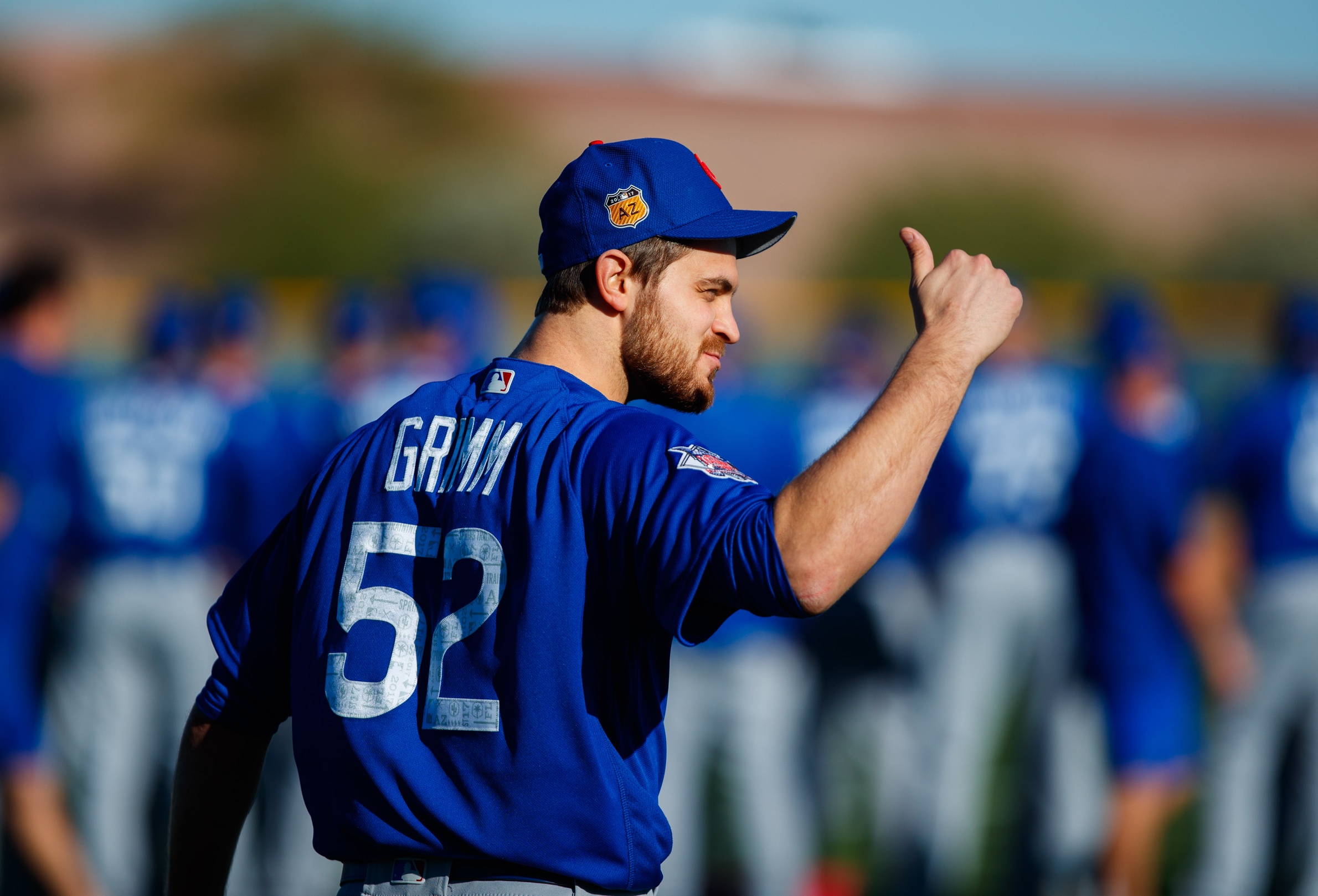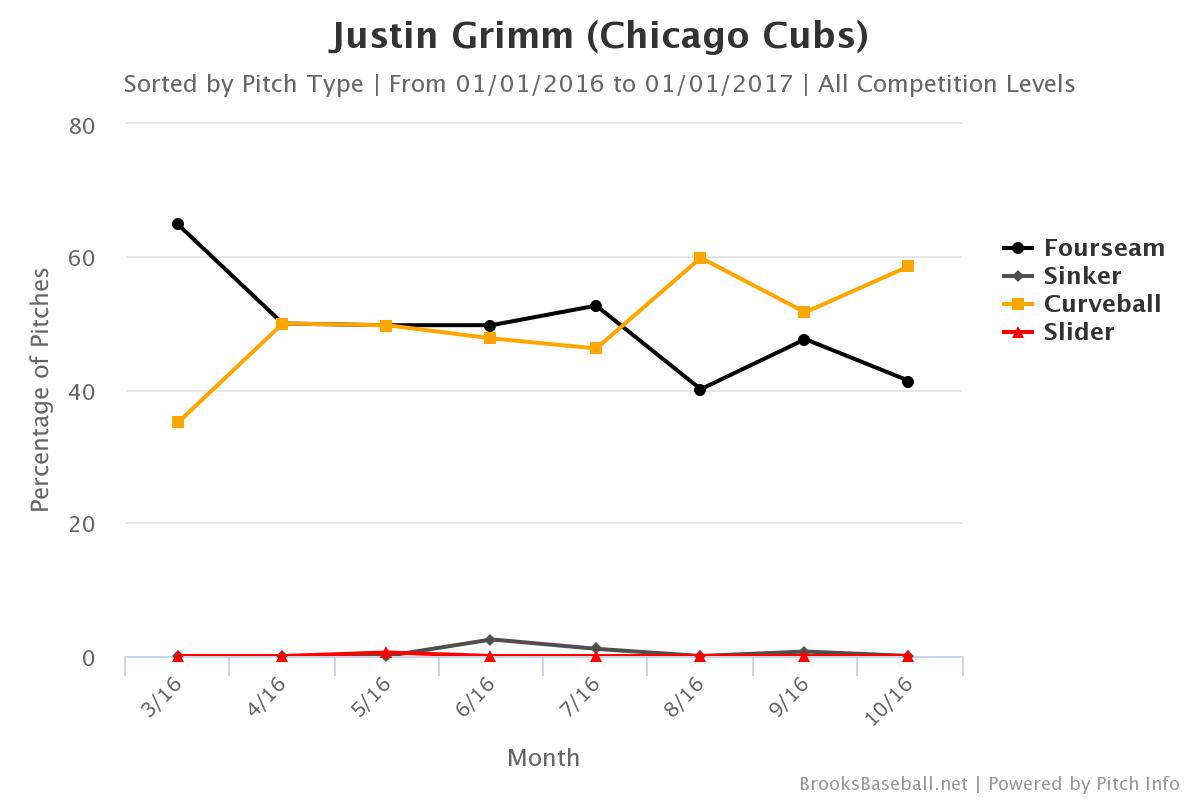Justin Grimm has always been a player that carries a lot of intrigue for me. At one point, his role was an uncertain one, because he had some elements of his game that were reminiscent of a guy who could slot into the rotation long-term. Of course, that never quite came to fruition. Instead, he’s become an asset out of the Chicago bullpen in his three full seasons with the team, showcasing an ability to pitch in a variety of situations. At the same time, 2016 represented something of a down year in certain respects for Grimm, leaving his value and his role moving forward up for a bit of questioning.
Not that Grimm was an abomination. He was sent to the minors on two separate occasions last year, but his overall numbers weren’t necessarily atrocious. However, they did represent a decline from his production in 2015, where he was one of the more effective relievers that the Cubs had coming out of their ‘pen.
| IP | W-L | K% | BB% | WHIP | ERA | FIP | DRA | |
|---|---|---|---|---|---|---|---|---|
| 2014 | 69 | 5-2 | 24.0 | 9.3 | 1.25 | 3.78 | 3.18 | 3.40 |
| 2015 | 48.7 | 3-5 | 32.8 | 12.8 | 1.15 | 1.99 | 3.14 | 2.95 |
| 2016 | 52.7 | 2-1 | 28.9 | 10.2 | 1.33 | 4.10 | 3.32 | 3.53 |
There were times last year where Grimm looked like a dominant asset out of the bullpen who Joe Maddon could plug into any given situation. And then there were other times. His June featured an ERA over 10 and he finished the year out with a 6.14 mark in the season’s final month. Of course, there were also months of 2.57, 0.00, and 0.82 that lend themselves to optimism heading into 2017.
While the FIP and DRA indicate that his ERA wasn’t quite as bad as it might look initially, he did experience the decline in his punch out rate as well. At the same time, there are some elements of last year that could represent concerns. According to FanGraphs, he gave up significantly harder contact than he did in the previous year, going from a 30.9 Hard% to a 36.8 percent figure. His groundball rate declined for the third consecutive year, falling down closer to the 40 percent range. He also stranded fewer runners, with a 73.4 percent LOB rate that represented a three percent decrease from the previous season.
One positive element of this is that Grimm’s “stuff” hasn’t changed much. His velocity has remained constant almost entirely across the board. And there wasn’t necessarily anything in his usage, from month to month, that indicated that he should’ve struggled over the course of the year as much as he did:
There’s a potential “luck” element here as well. Grimm’s pitch location in his good months, like April and May, didn’t differ all that much from a month like June. He also surrendered a .321 BABIP to opposing hitters, which is easily his highest figure from the last three seasons. While he did allow a high Hard%, it was somewhat inflated by a first month in which that figure was over 56 percent. Even in the months where that percentage of hard contact came down, hitters were still routinely posting high BABIP numbers off of him. When you couple that with a transition to an overall higher usage of the curveball, which could have led to some missed spots and a slight increase in free passes, that could indicate something of a run of bad luck and could allow us to be more optimistic moving forward.
It’s not a coincidence that the months in which Grimm struggled the most, statistically, his strikeouts were down and his walks were up. That brutal June featured a K% of just about 20 percent, his lowest percentage of the year. June and September/October both included walk rates over 16 percent, with the final month of the season representing his highest percentage of the entire year, at 16.7 percent. And while he used his curveball significantly more over the course of 2016, its usage didn’t fluctuate enough in those months to suggest that he should’ve been issuing as many free passes as he did (because my own assumption would be the heavy curveball utilization for all of 2016 would lead to an increase in walks— something not indicated by the numbers from month to month).
It would seemingly be oversimplifying things if we just looked at Grimm’s output in 2016 and chalked some of his struggles up to command and pitch selection more than anything. But that might really be what it all comes down to. His splits aren’t terribly significant either way that should indicate certain types of batters hitting him harder or more successfully than another. And the contact distributions aren’t in any way alarming in those months compared to the others. This might just be a case of a guy missing his spots in certain situations and experiencing some bad luck in others.
Should that be the case, we could very well see a Justin Grimm that returns to the form closer to that of 2014 and 2015. Returning to a point where he utilizes his fastball, which brings great velocity, and using his curveball to play off of the heat more often, could be a good place to start. Especially if his insistence on continuing to be a predominantly two-pitch reliever is to continue. There needs to be a balance there. If he’s able to do that, this is a pitcher capable of performing for the Cubs in a variety of spots, whether in middle or long relief, as well as essential late-inning situations. There aren’t a lot of guys with a skill set that could allow them to do that, so a return to form would make Justin Grimm a tremendous asset for the Cubs.
Lead photo courtesy Mark J. Rebilas—USA Today Sports


He sure has looked spectacular in Spring Training.